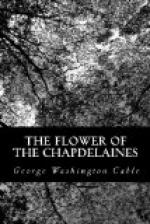I was a slim, tallish girl of scant sixteen, who had never seen a slaveholder on his plantation, though I had known these two for years, and loved them dearly, as guests in our Northern home before it was broken up by the death of my mother. Father was an abolitionist, and yet he and they had never had a harsh word between them. If the general goodness of those who do some particular thing were any proof that that particular thing is good to do, they would have convinced me, without a word, that slaveholding was entirely right. But they were not trying to do any such thing. “Remember,” continued my uncle, smiling round at me, “your dad’s trusting you not to bring back our honest opinion—of anything—in place of your own.”
“Maud,” my aunt hurried to put in, for she knew the advice I had just heard was not the kind I most needed, “you’re going to have for your own maid the blackest girl you ever saw.”
“And the best,” added my uncle; “she’s as good as she is black.”
“She’s no common darky, that Sidney,” said aunt. “She’ll keep you busy answering questions, my dear, and I say now, you may tell her anything she wants to know; we give you perfect liberty; and you may be just as free with Hester; that’s her mother; or with her father, Silas.”
“We draw the line at Mingo,” said uncle.
“And who is Mingo?” I inquired.
“Mingo? he’s her brother; a very low and trailing branch of the family tree.”
As we neared the house I was told more of the father and mother; their sweet content, their piety, their diligence. “If we lived in town, where there’s better chance to pick up small earnings,” remarked uncle, “those two and Sidney would have bought their freedom by now, and Mingo’s too. Silas has got nearly enough to buy his own, as it is.”
Silas, my aunt explained, was a carpenter. “He hands your uncle so much a week; all he can make beyond that he’s allowed to keep.” The carriage stopped at the door; half a dozen servants came, smiling, and I knew Sidney and Hester at a glance, they were so finely different from their fellows.
That night the daughter and I made acquaintance. She was eighteen, tall, lithe and as straight as an arrow. She had not one of the physical traits that so often make her race uncomely to our eyes; even her nose was good; her very feet were well made, her hands were slim and shapely, the fingers long and neatly jointed, and there was nothing inky in her amazing blackness, her red blood so enriched it. Yet she was as really African in her strong, eager mind as in her color, and the English language, on her tongue, was like a painter’s palette and brushes in the hands of a monkey. Her first question to me after my last want was supplied came cautiously, after a long gaze at my lighted lamp, from a seat on the floor. “Miss Maud, when was de conwention o’ coal-oil ’scuvvud?” And to her good night she added, in allusion to my eventual return to the North, “I hope it be a long time afo’ you make dat repass!”




